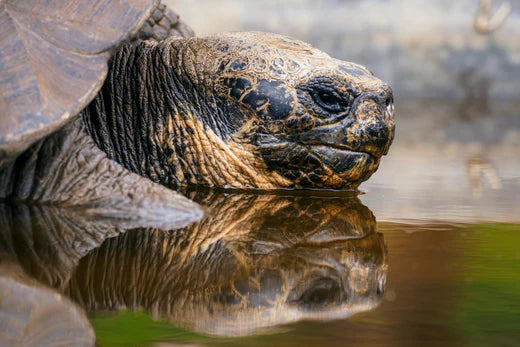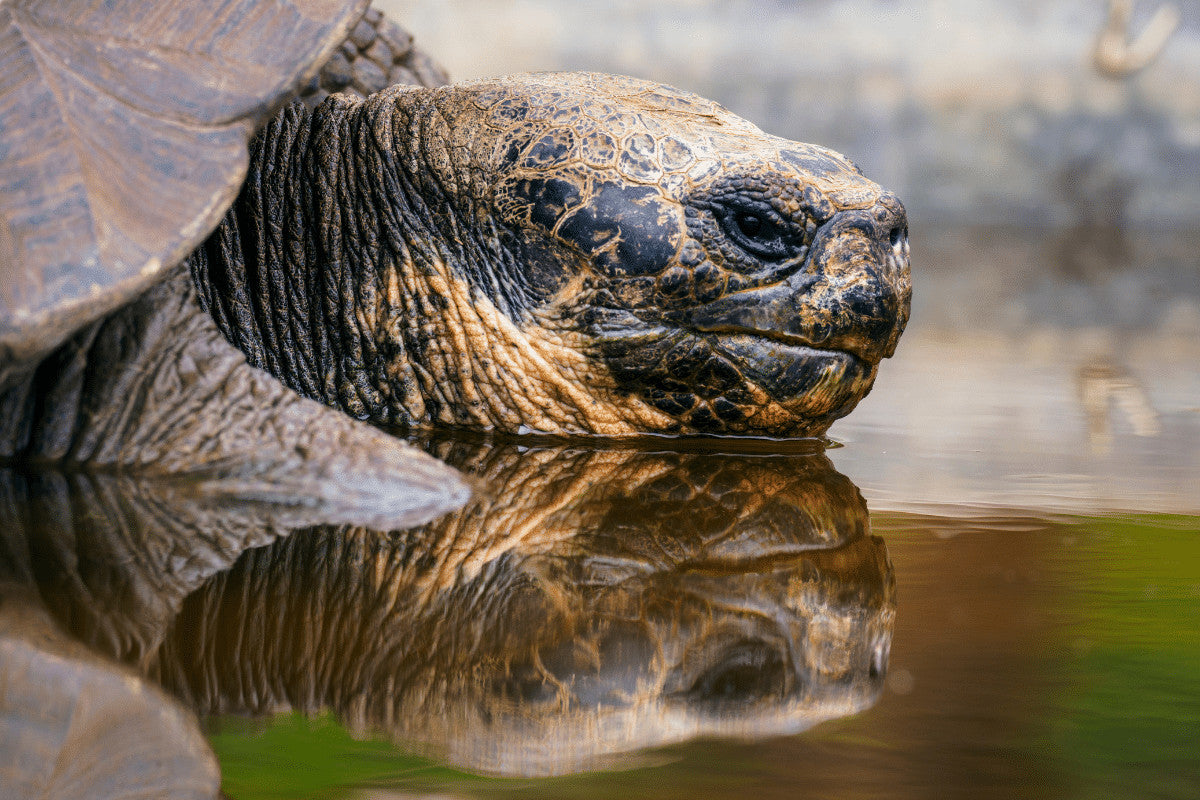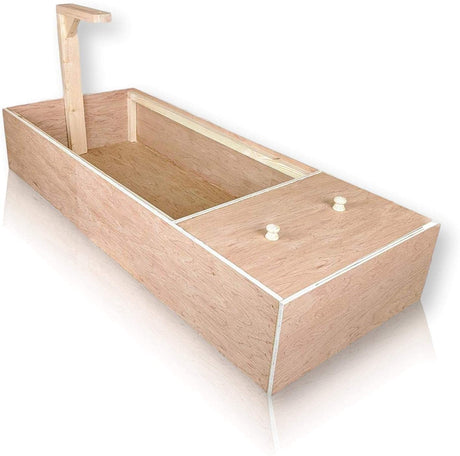So, can tortoises swim underwater? What is the difference between a tortoise and a turtle? Does my tortoise need water? These are all important questions we are about to cover to help you keep your shelled friend safe and happy.
Turtles vs. Tortoises
The name "turtle" actually refers to tortoises, terrapins, and sea turtles, as it really just covers anything within their taxonomic family that is a shelled, egg-laying reptile.
However, there is an obvious difference between tortoises and turtles; tortoises live on land whereas sea turtles spend most of their lives in the water. When you look at them more closely, you can start to see why turtles can swim and why tortoises are better suited for life on land.
Flippers vs. Feet
If you take a closer look at sea turtle feet you will notice that they are actually more like flippers. Although they come on to the beach to make their nests and lay eggs, turtle's feet are designed to be able to propel them through the water which is very useful as they live most of their lives in the ocean. Meanwhile, the webbed feet of aquatic turtles, like terrapins, are slightly different as they also have claws that allow them to move well both in the water and on land.

Tortoise feet, on the other hand, look more like elephants feet; they have clawed toes and bent legs that allow them to walk on land. Unlike turtles who are restricted in their choice of habitat, tortoises can survive in a range of different environments therefore they require something a little more sturdy to help them along. The claws on their feet may assist them with digging their burrows but they would not be very useful for swimming.

Shells
Another difference to look at would be the shapes of their shells; an aquatic turtle has a streamlined shell that allows them to move through the water with ease. A turtle's shell is flatter and also more lightweight than the shell of a tortoise.
Land-dwelling tortoises, however, have much larger, domed shells which are not aerodynamic in any way.

So Why Can't Tortoises Swim?
Without streamlined shells or flippers, it's no wonder that tortoises can't swim. A sea turtle has evolved over thousands of years to be able to glide through deep water, whereas tortoise evolution has created a body structure that allows them to live safely in their natural habitat on land. Their thick legs and heavy shells are just not equipped to help them stay afloat, let alone swim underwater.
Can Tortoises Float?
There is varying information about whether or not tortoises can float and we do not want to encourage anyone going out to try and find out by themselves! It is said that it depends on various factors such as the age of the tortoise, their size, as well as the species.
In our eyes, it's not worth the risk and it's better to play it safe and not let your tortoise in water too deep. Whether your tortoise can float or not, it is likely going to cause them stress and puts them at serious risk of drowning.
Knowing the Difference
There have been many reported incidents of when people mistake tortoises for turtles and then place them in water, thinking that they will swim away.
Unfortunately, as we now know, turtles and tortoises are not the same and only one of them is equipped for swimming, therefore it's important to know the difference so that you do not make the same mistake.
If you find a turtle and can't tell whether it is an aquatic turtle or a tortoise then check for webbed feet and observe the shape of its shell. Although freshwater turtles, sea turtles, and pond turtles may have different shaped shells, they all boast a more streamlined shape than their taxonomic cousins; even baby tortoises have noticeably taller, dome-shaped shells which should be easy to identify now that you know.
Either way, the safest option is to leave the shelled reptile where you found it; if it happens to be a turtle then they will move back into the water when they are ready, while a land-dwelling tortoise will continue their journey in the other direction, away from the water.
Tortoises and Water
Now we have established that most tortoises cannot swim, let's go into some more specifics.
In The Wild
Most tortoise species will seek out shallow water sources for bathing or to have a drink of water. It is not uncommon to see tortoises hanging out on the water's edge to cool off on a hot day. However, if you see any shelled reptiles swimming, these are most likely going to be a turtle species.

Can Tortoises Survive Underwater
The short answer is "no". Although sea turtles have evolved to hold their breath for as long as seven seven hours, most land-dwelling tortoise species cannot hold their breath for more than a few minutes and will drown if left in deep water for very long.
Therefore, as a tortoise owner, you should never provide water that is too deep for your pet tortoise to stand up in, for their own safety.
Bathing Your Tortoise
As we mentioned previously, although most tortoises can't swim, they do like to bathe in water. You can prepare a quick bath for your pet tortoises in your bathtub, sink, or even a large tub of water. Here are a few things you should keep in mind when bathing your tortoise:
- Remember, they cannot swim and are not aquatic turtles so you only need to provide around an inch of water, depending on the size and specific species of your tortoise. You need to make sure that if your tortoise decides to lay down, their head will not be submerged.
- Never leave your tortoise unattended when in a bath, especially in a rounded sink where they may be able to flip upside down and drown.
- Use lukewarm water; water too hot or too cold can be uncomfortable for your pet.
- Your tortoise may poo in its bath and that's perfectly normal.
- Always put them back into their enclosure when they are dry.
Some tortoises do not enjoy being in the water at all therefore if they seem to be trying to climb out then you should take them out, dry them, and put them back into their home.
If, however, they do enjoy their bath, you can take a soft toothbrush and use the opportunity to clean their shell and legs. It's important not to use any soap as it can irritate your tortoise's skin or cause serious harm if ingested.
Drinking Water
As with many other animals, tortoises drink water on a regular basis. Your pet tortoise should have access to a shallow water bowl and you must provide them with fresh water on a daily basis.
Pet tortoises are often known to go and sit in their water bowl so be prepared to clean it out more frequently if they drag substrate into it or poo in it!
Final Thoughts
We hope that has covered everything you need to know about whether tortoises can swim or not. To summarise, turtles and tortoises are two different species of animals that have evolved to live in different habitats. While turtles live in the ocean and can swim incredibly well, tortoises live on land and you most definitely will not see them swimming any time soon.
Despite this, it doesn't mean that your pet tortoise won't enjoy soaking in their water bowl every now and again, or that you can't treat them to a little bath.
Just remember to never put your tortoise at risk and follow our guidelines for a happy and safe tortoise! Does your tortoise like their baths? Let us know in the comments!





8 comments
May now deceased sister, Linda, had a fairly big tortoise that she named.. I just do not remember the name. Linda, a cat called, Andrew, lived a very happy life together in my sister "s apartment . Several years later when Andrew died, , My sister took Andrew to the woods for burial and returned the tortoise to the wild.. I have been reading for several days from your videos and literature about your publication on turtles
Hiii! Greetings from Barbados 246!! It’s 8:00 a.m.here!!
Praise God! My 6 baby tortoises survived the ordeal!! They are ALL HEALTHY!! They appetite is as voracious as before! The Vet said “They are fine!” :-)
Hi! Ì took my 6 baby tortoises ìn their container outside to clean and a very HEAVY torrential dowpour of rain just happened to fall for about over an hour…when I remembered tortoises I found 5 of them submerged in approx. 3 in of water & 1 little fellow swimming vigorously on top.:-(… I quickly threw out the water & the tortoises & brought them in… I am presently here praying that God would send them a miracle…my great grañds will be traumatized if they died…I will update you on their progress since this is currently happening…It is 3:20 a.m. here in Barbados. I paused to Google What to do!! This site has helped me tremendously!! Thanks for your write up!!
Wow, your hard work really shines through in this project. It’s evident that you put a lot of effort and dedication into it. Your attention to detail is impressive, and the results speak for themselves. Keep up the great work, and I can’t wait to see what you achieve next. You can also read about Do wolves have night vision
Goodness, I thought tortoises and turtles are reptiles that can breathe in air and in water!
Hello!
My tortoise lives in my garden . My problem now is that I shall be be away for 3 months and I would like to know how to protect him from drowning under heavy rain and a flooded soil. Thank you in advance for your reply!
Thanks my kids.love our Herman tortoise so they loved bath time…
my hermonds tortoise loves water .he acct sulks when i pull him out.he swims and floats realy well .i dont acct see how he could ever drown.unless he got caught in or on something .tho i spose not all are the same